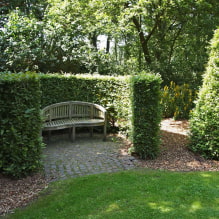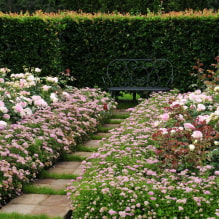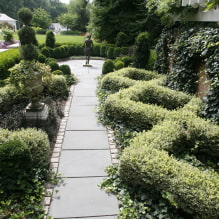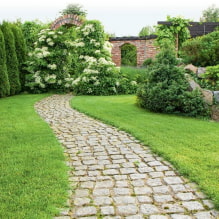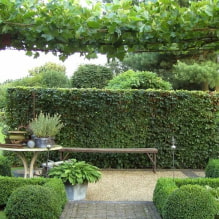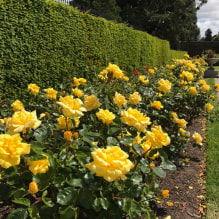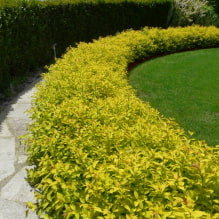Thuja – soft needles
The softness of the needles, the variety of sizes and shapes, as well as the endurance of the thuja make this plant popular among gardeners. Varieties reaching three meters in height are used to create hedges. Compact forms are suitable for internal zoning of the site and arrangement of borders. A combination of different varieties of thuja in landscape design looks impressive.
Plants are planted at a distance of 70-100 cm from each other. If you need to provide a dense green fence, resort to a double-row staggered planting.
For a moderate climate, the pyramidal thuja variety Smaragd is best suited. The advantage is that they do not need pruning and feel comfortable in urban conditions. You can also plant a hedge of fast-growing Brabant thuja, however, in the cold season, the plants of this variety change their color to brown, which makes such a fence more suitable for a summer house than for an urban environment. Brown cones that form on Brabant thuja can spoil the impression of a living fence.
A disadvantage of thuja is that the needles burn out in the bright sun. Dry branches can negatively affect the appearance of the fence.
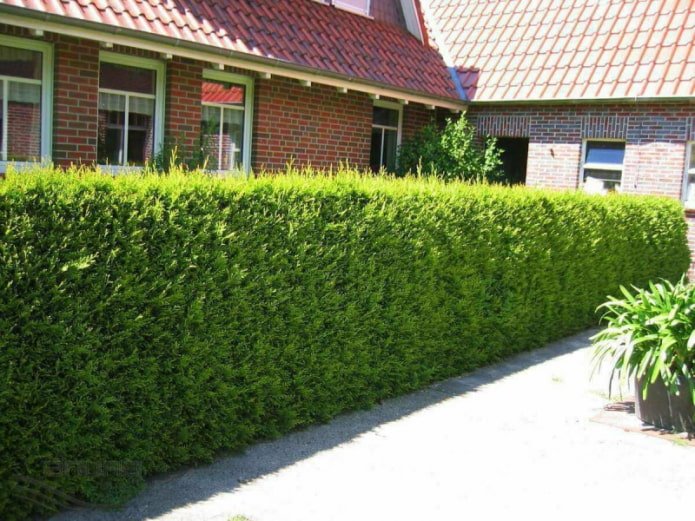
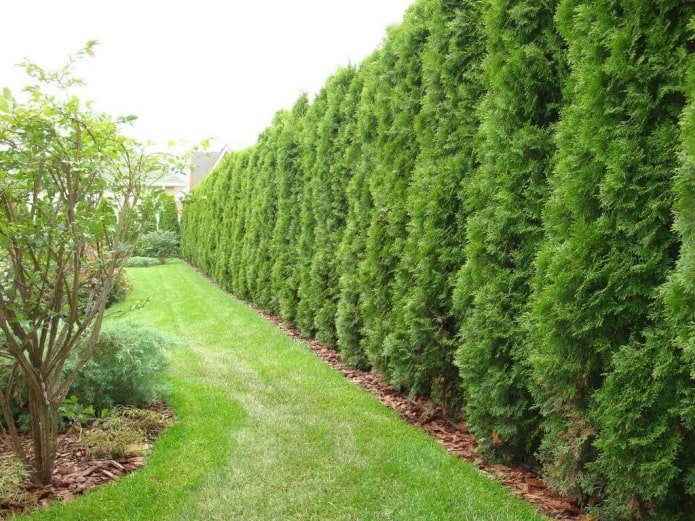
Cotoneaster lucidus – a bright change
The dense glossy foliage of the cotoneaster ensures its beauty throughout the warm season. The bush, 0.5 to 1.5 m high, changes its color to burgundy-brown by autumn, and the dark berries make the plant look even more attractive.
Thanks to its decorative qualities and ease of care, the glossy cotoneaster is ideal for creating a hedge. The plant can be trimmed, shaping its crown as you like. Another advantage is that the berries are not poisonous, so you can grow cotoneaster without fear for the safety of others.
A special feature of care is that formative pruning should be performed regularly. This is due to the fact that cotoneaster is a fast-growing shrub for a living fence.


The photo shows a long hedge of cotoneaster lucidus in autumn. A burgundy fence trimmed in one line attracts with its brightness and neatness of form.
Spiraea – the elegance of inflorescences
You can grow a hedge from spirea. A profusely flowering shrub, reaching a height of up to one and a half meters, is distinguished by its beauty. Both fertile soil and ordinary garden soil are suitable for its cultivation.
Among the advantages of spirea are lush flowering, a variety of varieties, and the ability to take various forms. By combining plants that bloom at different times, you can achieve continuous flowering of a border or a living fence of medium height. It is necessary to choose varieties carefully, since they differ in growth rate, size of an adult bush, and shade of foliage.
To ensure that the appearance of the fence does not lose its neatness, it is necessary to remove faded inflorescences. Since spirea produces a lot of flowers, pruning can take a lot of time.
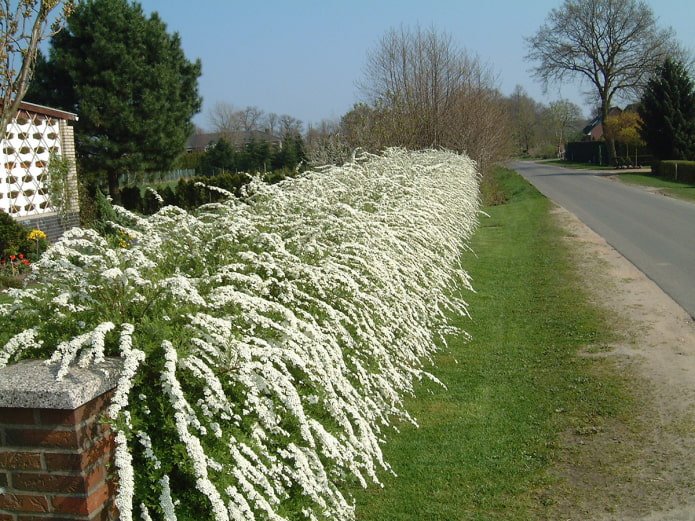
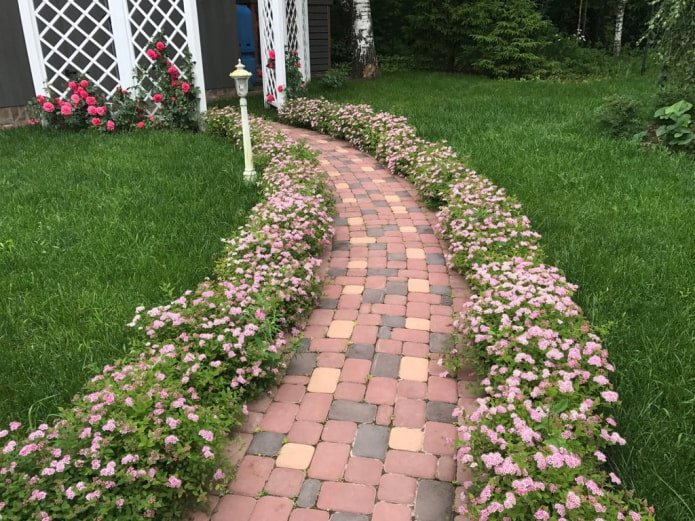
The photo shows an example of a spirea border. The plant used to decorate the path retains an attractive appearance even after flowering, thanks to the bright color of the leaves and the natural neat shape of the hedge.
Barberry Thunberg – a riot of colors
The bright color of the barberry Thunberg captivates with its beauty. The color palette varies from rich yellow-green to deep burgundy-violet tones. The leaves of different varieties are painted in one shade, have a colored border along the outer edge or are decorated with strokes and spots. In some species, bright green summer foliage in the fall is replaced by luxurious shades of red. Small red berries also serve as a decoration for the plant.
With the help of this bush, you can create both a low border and a medium-sized hedge. You can fully enjoy the beauty of the hedge in sunny areas, since in the shade the foliage loses its decorative color and becomes more sparse.
The disadvantages of barberry include the fact that its branches are covered with thorns about 2 cm long. You should approach pruning and care with caution.
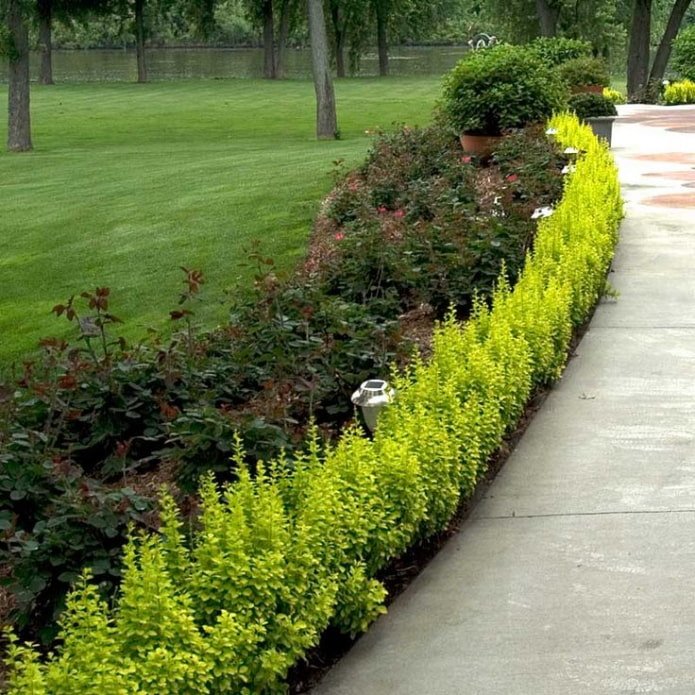
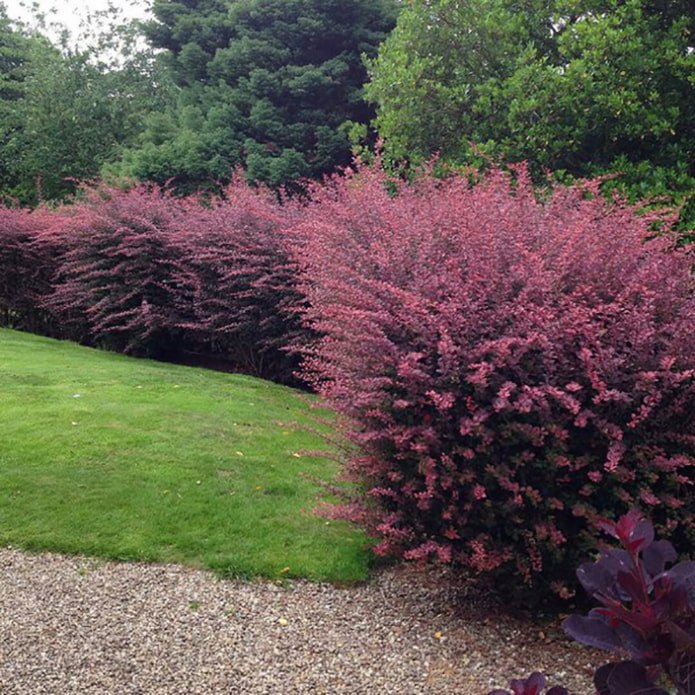
Lilac – the luxury of flowering
In late spring and early summer, lilac fences are strewn with delicate flowers and exude a scent that many associate with the onset of the warmest time of the year. For a hedge, it is better to choose frost-resistant varieties that are resistant to drought and unpretentious in care. Amur, Hungarian lilac, as well as Mayer lilac are ideal.
The advantage of such bushes is their resistance to diseases. They are not affected by harmful insects. Caring for lilacs is not burdensome, formative pruning of branches is enough. Every year it is also necessary to remove young shoots that begin to grow next to adult bushes.
The disadvantage of such a fence is that after a short flowering, lilac loses its decorative effect. However, the beauty of the lush flowers compensates for this shortcoming.
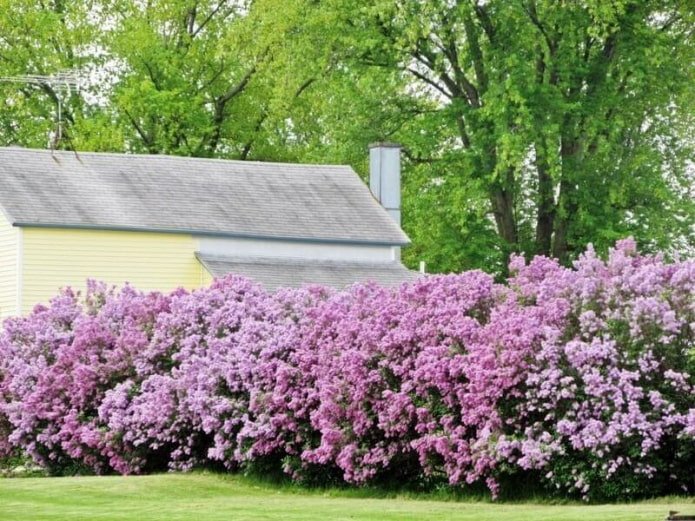
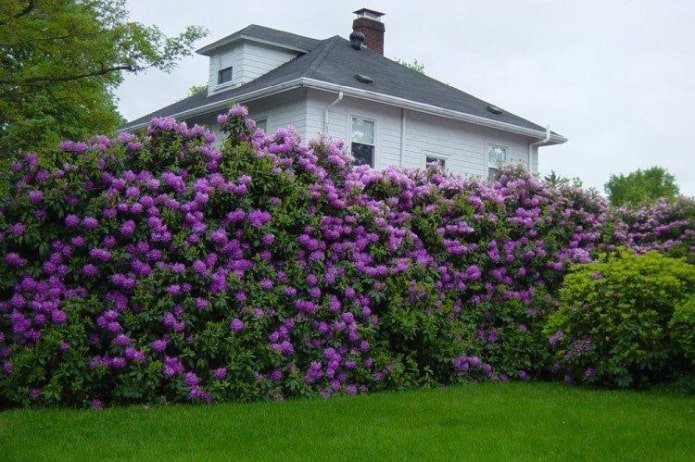
Willow – a variety of forms
Willow hedge is rapidly gaining popularity. With its help, landscape designers achieve an effective design of the boundaries of the territory and protection of the site from penetrations. Willow is undemanding to weather conditions and does not require special care.
Among the variety of species, you can choose plants suitable for solving different problems. Dwarf willow is suitable for creating borders. Compact shaggy willow is ideal for zoning the territory. Rosemary-leaved willow allows you to form a green hedge in damp shady areas of the garden. With the help of tall representatives, you can also create unformed fences.
The advantage of willow is that the planting material is available and has a low price. Willow is not demanding to the planting site and special care. Plastic shoots can be intertwined. Pruning helps to give the hedge the shape of a fence or an openwork gazebo.
A special feature of care is regular pruning. Without it, the willow grows uncontrollably, and the fence loses its decorative appearance.
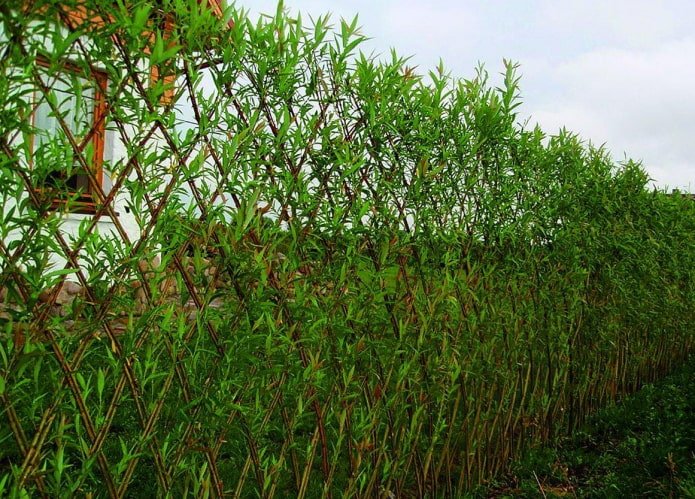
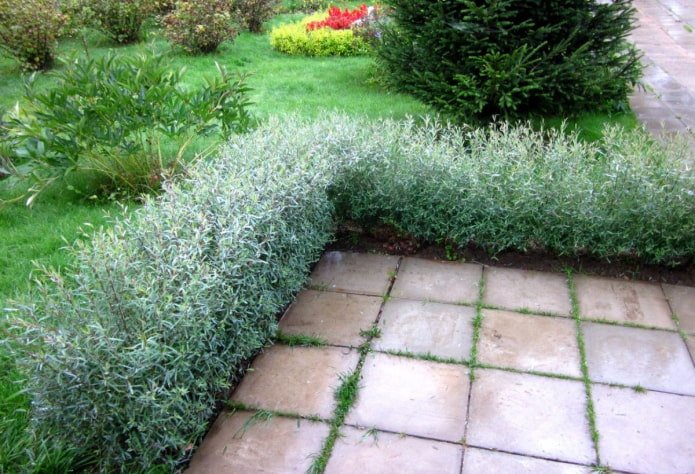
Rose – the queen of the garden
A wall of roses or a low hedge planted along the border emphasizes the luxury of the garden. Caring for roses can be a difficult task for a gardener, but the beauty and sweet aroma of these flowers win the heart and make you not afraid of difficulties.
Breeders have developed relatively unpretentious varieties that are suitable for growing hedges on a plot. Plants up to 50 centimeters high are ideal for arranging borders, roses from 0.5 to 1.5 meters – for a compact hedge, bushes from 1.5 to 2 meters – for a medium fence, large varieties over 2 meters – for a green wall strewn with noble flowers. The latter sometimes need additional support, so they are fixed on vertical surfaces.
To maximize the decorative effect, it is important to select roses of the same variety or use several types with the same dimensions and flowering periods. Rose seedlings must be planted in one row. Roses look great next to conifers, which will emphasize the attractiveness of the hedge in the cold season.
The disadvantage of the fence is that roses often do not tolerate frost well. To make care easier and solve the problem of wintering, it is necessary to select varieties that do not require shelter.

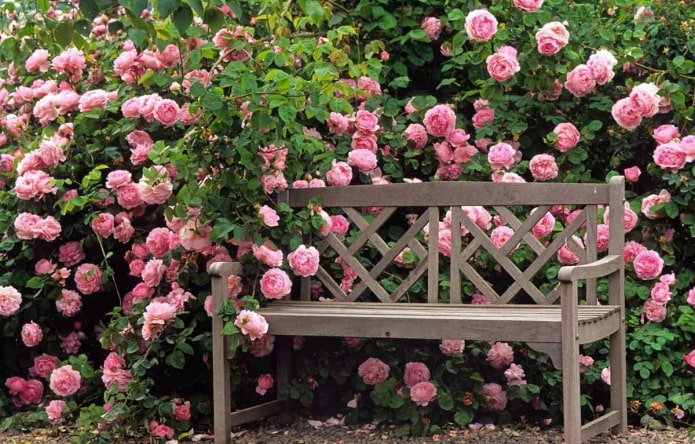
The photo shows how a rose border decorates the site. The elegance of the flowers, the sophistication of the aroma and the splendor of the flowering compensate for all the difficulties of caring for roses.
Hawthorn blood-red – an unpretentious long-liver
This deciduous shrub becomes a decoration of the site for decades. In the spring, it is covered with delicate inflorescences. Carved leaves and bright red berries, which are formed by autumn, also decorate the hawthorn fence.
The bush feels comfortable in dry summer weather, tolerates low winter temperatures, and develops well in areas of the garden where sunlight penetrates with difficulty. Watering the bushes is not necessary. Hawthorn responds to pruning and actively forms new shoots, which makes it possible to create a solid green wall. Trimmed cuttings take root well, so hawthorn is very easy to propagate.
The disadvantage is the exposure of the lower part of the bush as it grows. To avoid this, formative pruning should be performed regularly.
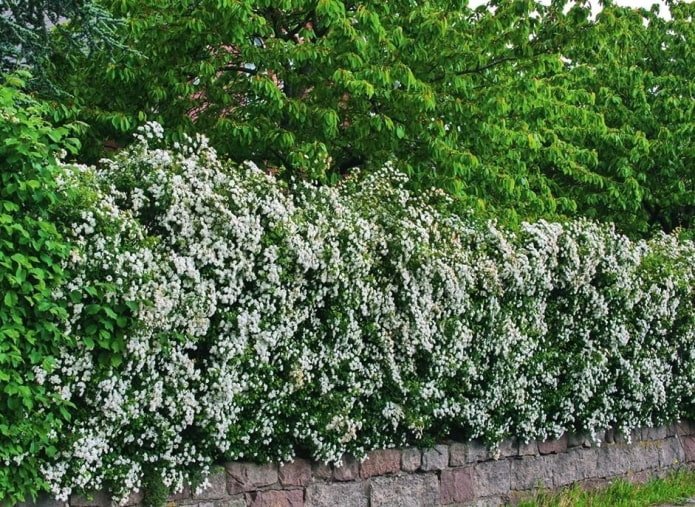
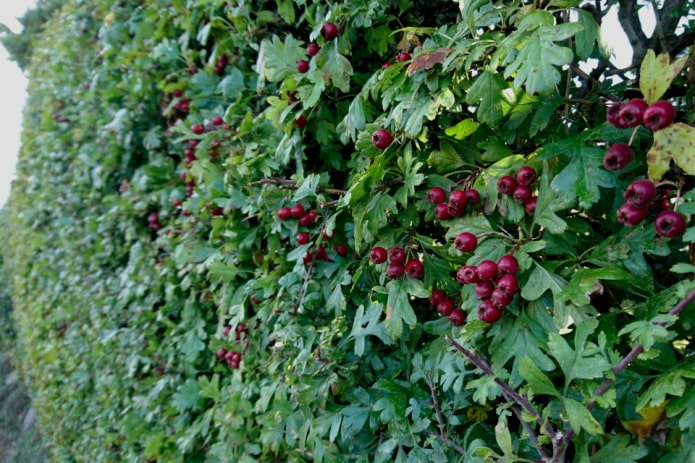
Boxwood – easy to shape
The tetrahedral leaves of boxwood are close to each other, forming a dense crown. After flowering, fruits appear on it. Among the variety of species, there are varieties with a single-color and variegated color, dwarf and tall varieties.
Slow growth and ease of pruning make the bush an excellent option for arranging a green fence that does not require frequent care. Boxwood grows best in partial shade. The more often the shoots are pruned, the more intensive the feeding should be. Watering is required only in hot weather and drought. Regular loosening of the soil ensures air flow to the root system.
In the open sun or in insufficient lighting, the plant develops slowly and may die. Boxwood is afraid of drafts and severe frosts. In order for the plant to survive the winter well, the bush must be covered with burlap in the fall, this will protect the boxwood from bright sunlight and cold.
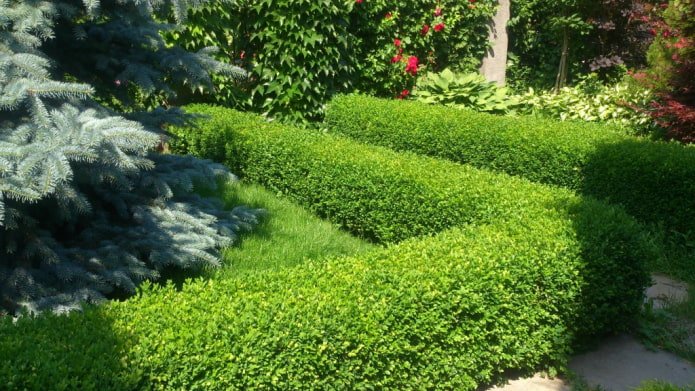
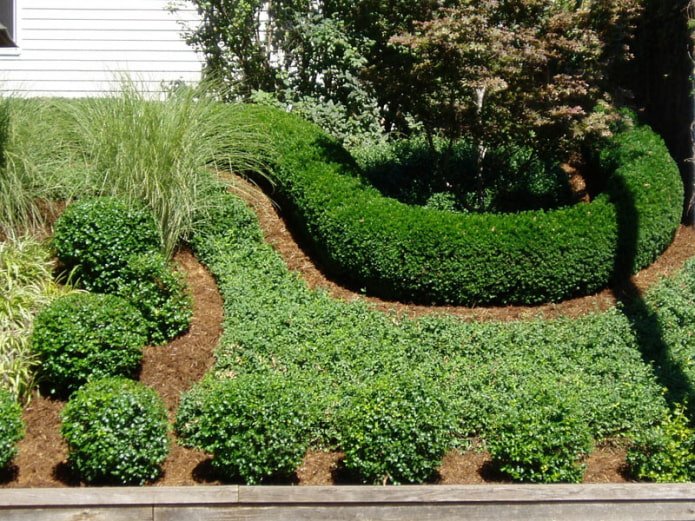
Mock orange – a delicate aroma
The height of this abundantly flowering shrub reaches 3 m, and the ability to quickly grow even after pruning soft branches half the length makes it an ideal choice for creating a high hedge. Thanks to the bright green leaves, the bush retains its attractiveness even after flowering.
The advantage of jasmine is that it is frost-resistant and unpretentious in care, so it is perfect for growing in the climatic conditions of the middle zone. Long-lasting abundant flowering, delicate aroma are also its advantages.
To reveal the full potential of the plant, it is necessary to choose a place with good lighting for planting. It is better if the soil is not compacted or waterlogged.

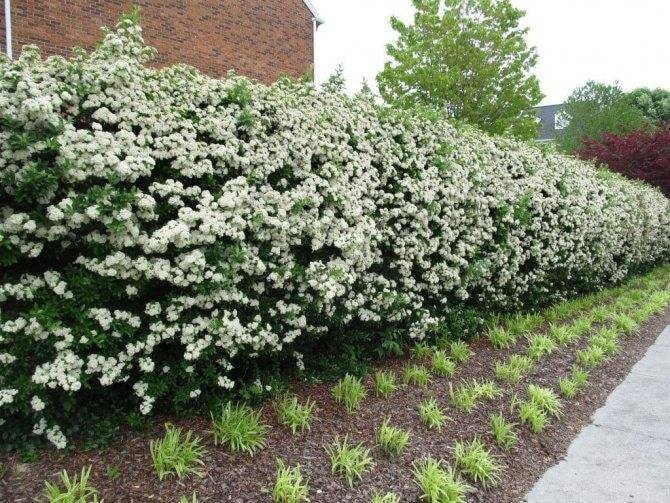
Physocarpus viburnifolia – expressiveness of colors
A tall ornamental deciduous shrub, characterized by spreading branches, can be transformed beyond recognition by pruning its shoots. This stimulates the formation of a lush crown and makes the bladder senna an excellent choice for arranging a hedge. By combining varieties that differ in the color of their foliage, you can create original fences that attract admiring glances.
The bladder senna grows well even on infertile soils. The high growth rate leads to the fact that in a fairly short period of time, the gardener can get a dense green wall or a fence of a dark burgundy hue. The bush feels comfortable with a lack of moisture, plant diseases do not affect it, and pests bypass it. Even a person without extensive experience in gardening can prune the crown.
No disadvantages have been identified for the bladder senna. Experimenting with pruning shapes and colors, you can easily create a spectacular living fence from physocarpus on your site.
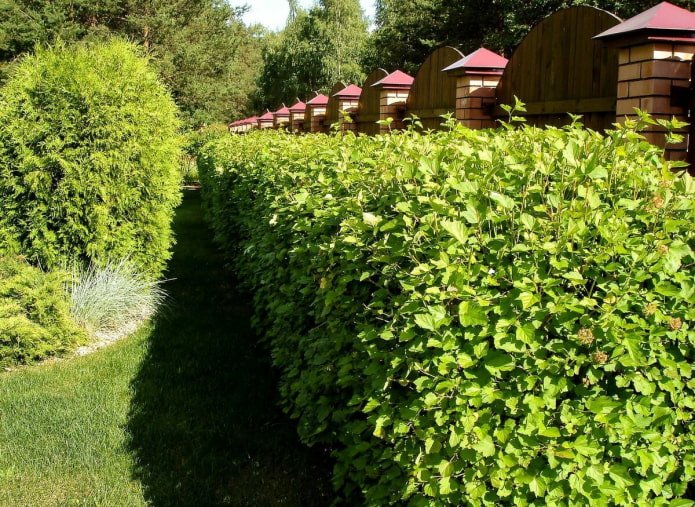
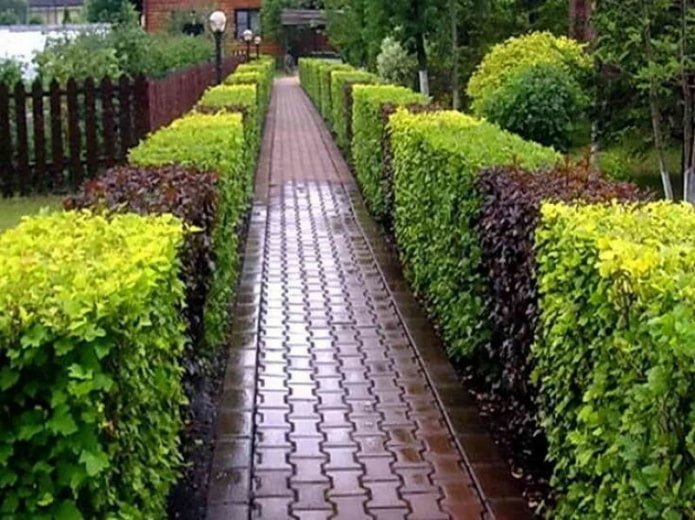
Juniper – green all year round
Juniper has beautiful needles that never fall off. A coniferous plant looks impressive when planted in a flowerbed and framing a garden path. Juniper is also actively used in landscape design to create hedges.
Among the variety of species, you can choose bushes that are suitable for growing a high fence or a low hedge. Each variety is characterized by drought resistance. Common juniper, Cossack, Virginian, scaly or Chinese is best grown in open areas of the garden, otherwise it loses its decorative effect, as the branches thin out.
Some may consider the slow growth rate of juniper, typical of conifers, a disadvantage. However, such a hedge looks compact and neat at any time of the year and does not require special care.
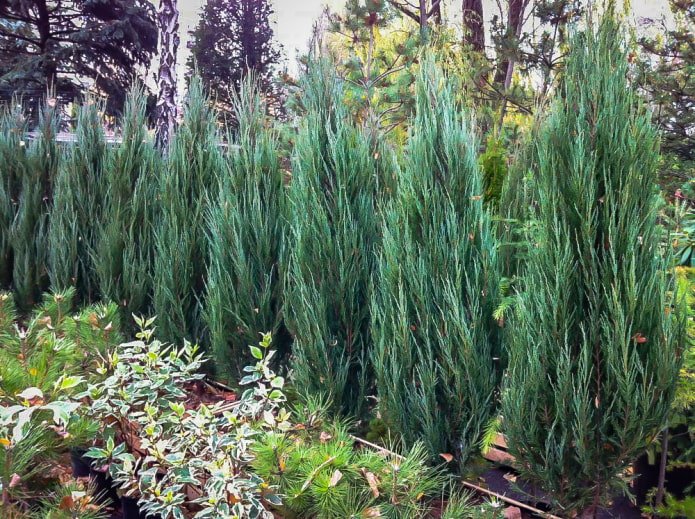
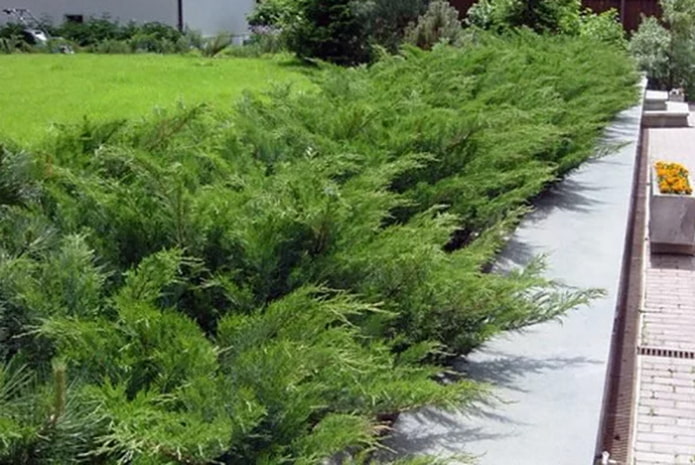
White dogwood – an exquisite decoration of the site
The deciduous shrub grows very quickly and reaches height of 3 m. Its decorative properties are preserved in winter, thanks to graceful bright shoots of a burgundy shade. The bushes bloom twice a season, and in autumn, white berries appear on them simultaneously with the flowers.
The advantage is that white dogwood is not demanding to growing conditions, adapts to heat and frost, does not require additional feeding, and reacts to pruning with vigorous formation of new shoots. In autumn, the leaves acquire a variety of colors, giving the bush additional attractiveness.
The disadvantage may be the need for regular pruning. If you do not follow these conditions, the bottom of the bush becomes bare and the fence looks untidy.
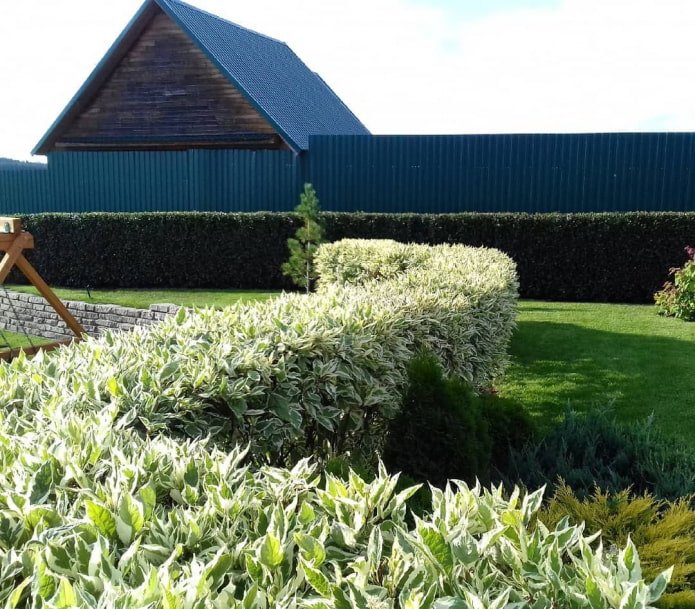
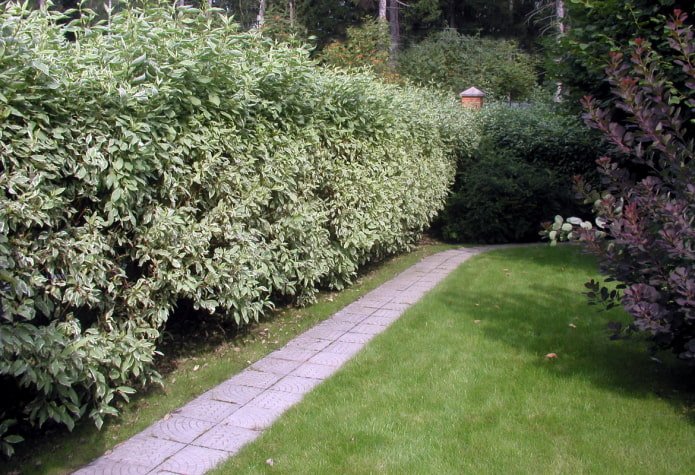
Privet – fast growth and endurance
Gardeners who want to get an impenetrable green hedge on their site should pay attention to privet. This shrub is characterized by rapid growth up to 2-2.5 m in height and shade tolerance.
Pruning can be used to give privet any shape. Privet does not require watering. It is not affected by pests and does not suffer from diseases that many representatives of the plant world are susceptible to.
Planting a hedge from this shrub should be done with caution only if there are small children nearby, since the berries of the plant are poisonous. This is the only drawback of privet.
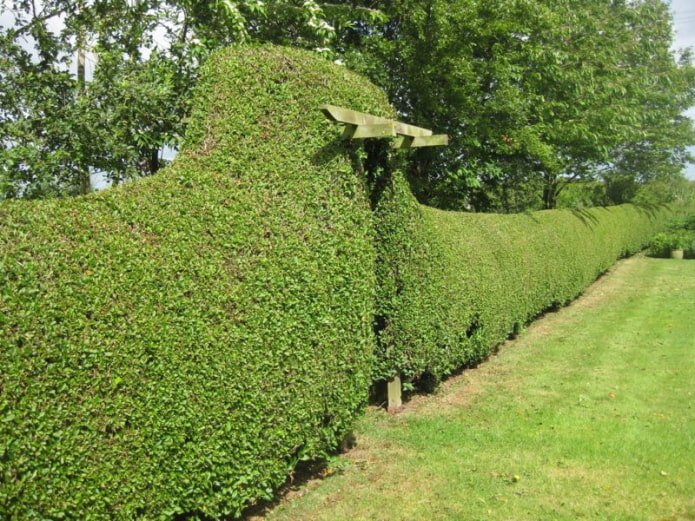
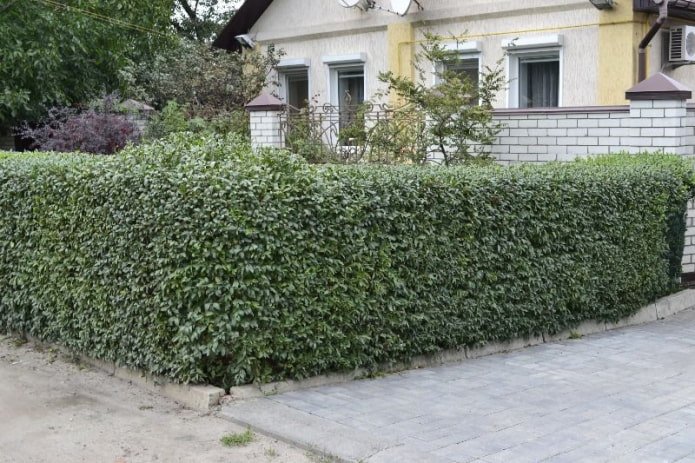
Chokeberry – beauty and medicinal properties
Aesthetic hedge of chokeberry is popular with gardeners. Delicious berries with medicinal properties give the bush even greater attractiveness. In autumn, chokeberry does not go unnoticed, its fiery red foliage attracts the eye.
Chokeberry does not need additional feeding, easily tolerates severe frosts and prolonged drought. To create a dense hedge, young seedlings should be planted in one row at a distance of 50-60 cm from each other. In order for chokeberry to develop faster and please with an abundant harvest, it is better to choose a sunny place for planting.
A feature of chokeberry is the formation of root shoots, which must be removed in time to maintain the neatness of the hedge. To give chokeberry a well-groomed appearance, pruning of fast-growing shoots should be done up to 3 times per season, which for some gardeners may seem difficult.

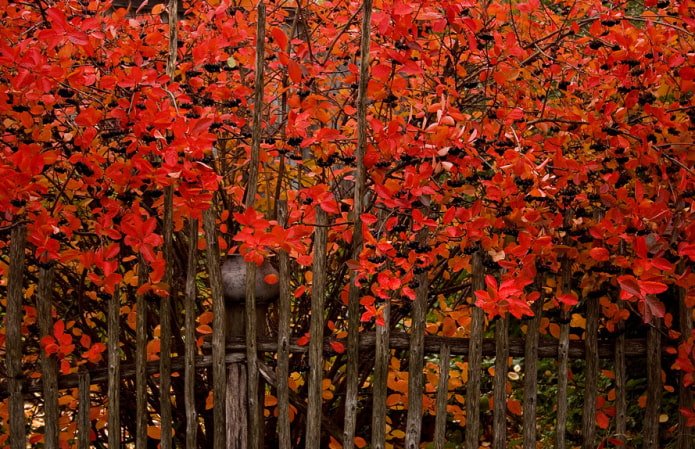
Real ideas for inspiration
The trees and shrubs suggested in the article will help to create hedges that will delight the owners of the site with their beauty for a long time. An effective green fence can also perform a protective function, closing the territory from unwanted views and preventing strangers from entering the site.
